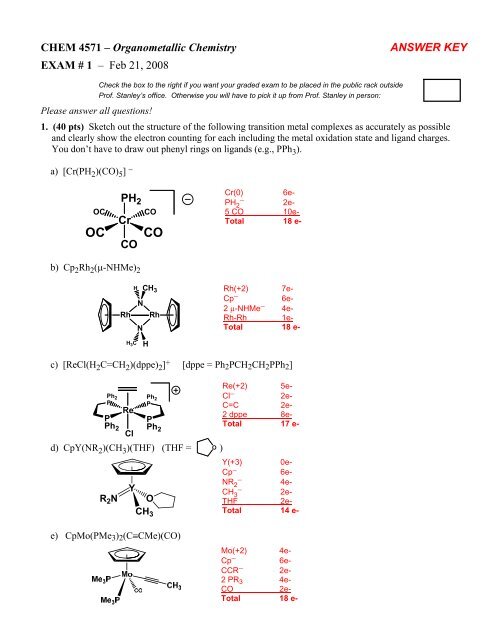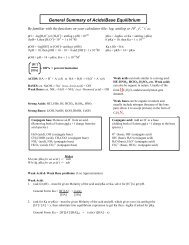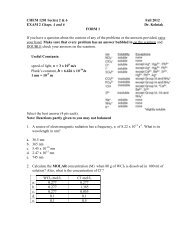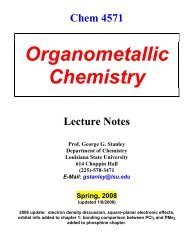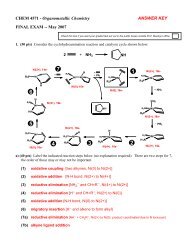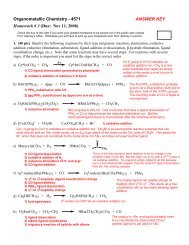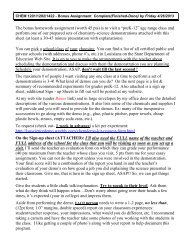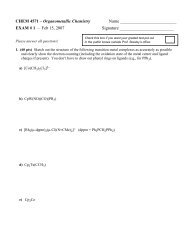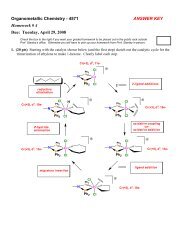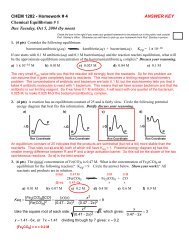Exam #1-Answers
Exam #1-Answers
Exam #1-Answers
You also want an ePaper? Increase the reach of your titles
YUMPU automatically turns print PDFs into web optimized ePapers that Google loves.
CHEM 4571 – Organometallic ChemistryEXAM # 1 – Feb 21, 2008ANSWER KEYCheck the box to the right if you want your graded exam to be placed in the public rack outsideProf. Stanley’s office. Otherwise you will have to pick it up from Prof. Stanley in person:Please answer all questions!1. (40 pts) Sketch out the structure of the following transition metal complexes as accurately as possibleand clearly show the electron counting for each including the metal oxidation state and ligand charges.You don’t have to draw out phenyl rings on ligands (e.g., PPh 3 ).a) [Cr(PH 2 )(CO) 5 ] −OCOCPH 2COCrCOCOCr(0) 6e-PH − 2 2e-5 CO 10e-Total 18 e-b) Cp 2 Rh 2 (μ-NHMe) 2HCH 3NRh RhNRh(+2) 7e-Cp − 6e-2 μ-NHMe − 4e-Rh-Rh 1e-Total 18 e-H 3 CHc) [ReCl(H 2 C=CH 2 )(dppe) 2 ] + [dppe = Ph 2 PCH 2 CH 2 PPh 2 ]Ph 2PPPh 2RePh 2PPPh 2Cld) CpY(NR 2 )(CH 3 )(THF) (THF = O )R 2 NYCH 3ORe(+2) 5e-Cl − 2e-C=C 2e-2 dppe 8e-Total 17 e-Y(+3) 0e-Cp − 6e-NR − 2 4e-CH − 3 2e-THF 2e-Total 14 e-e) CpMo(PMe 3 ) 2 (C≡CMe)(CO)Mo(+2) 4e-Cp − 6e-CCR − 2e-2 PR 3 4e-CO 2e-Total 18 e-
<strong>Exam</strong> # 1 (2008) 2f) [trans-AuI 2 Ph 2 ] − (Ph = C 6 H 5 )PhIAuPhAu(+3) 8e-2 Ph − 4e-2 I − 4e-Total 16 e-trans means that the two Ph − and I − ligandsshould be opposite one anotherIg) V(NMe)Cl 3 (CH 3 OCH 2 CH 2 OCH 3 )V(+5) 0e-NR 2− 6e-2 R-O-R 4e-3 CI − 6e-Total 16 e-h) Ir 2 (μ-Br) 2 (CO) 4OCOCIrBrBrIrCOCOIr(+1) 8e-2μ-Br − 4e-2CO 4e-Total 16 e-2. (40 pts) For each of the following pairs of complexes, which will have the lowest average CO infraredstretching frequency? Circle your choice and briefly explain your reasoning.a) CpFe(CO) 2 (PF 3 ) -or- CpOs(CO)(PMe 3 ) 2The most electron-rich metal with d-electrons will π-backbond the mostwith the CO ligands and have the lowest CO streaching frequencyThe Os complex has two strongly donating PMe 3 groups and only one π-backbonding CO, thus this one COligand will π-backbond more strongly with the metal center. The Os is also less electronegative and will be willingto π-backbond more strongly to the CO.b) Cp 2 Y(CH 3 )(CO) -or- Cp 2 V(CH 3 )(CO)The Y complex is a d 0 system and can not π-backbond to the CO. The V complex, on the other hand, is a d 2complex and has strongly donating Cp − and CH 3− groupsc) Cr(CO) 4 (PEt 3 ) 2 -or- W(CO) 4 (PPh 3 ) 2The two PEt 3 ligands on the Cr complex are strongly σ donating, considerably more so than the PPh 3 ligands.This more than compensates for the higher electronegativity of Cr vs. W.d) PtCl 4 (CO) 2 -or- NiBr 2 (CO) 2The Ni(+2) complex is more electron-rich than the Pt(+4) complex since it has a lower oxidation state (more delectrons) and better donor ligands (Br − vs. Cl − ). The Pt is less electronegative and has 4 donor ligands vs. justtwo for the Ni complex, so that tends to compensate and make them closer together. Since they could beconsidered reasonably close to one another based on these two different lines of reasoning, we will give full creditfor either answer so long as the justification is OK.
<strong>Exam</strong> # 1 (2008) 33. (30 points) a) (20 pts) Show the charges (may be 0) and number of electron pairs (may be zero) on thedonor atoms that will coordinate to the metal center for the following chelating ligands:F atoms attached to C or As are too electronegative to act as ligands.The As lone pairs are much higher in energy and better donors.b) (10 pts) Order the ligands above from strongest to weakest donor for a Zr(+4) metal center and includeyour reasoning. You can refer to the ligands by their primary donor atom type (e.g., S, O, N, etc) and donot have to sketch them out.O > N > S > AsZr(+4) is a “hard” early transition metal center that is highly oxophillic (oxygen-loving), especially foranionic “harder” ligands like O, N, C, or Cl. So the O (two anionic donors) > N (one anionic, one neutraldonor) ranking is fairly straightforward based on this. S and As are both “softer” ligands, but S is lesspolarizable than As (fewer core electrons) so it should bind more strongly relative to As-based ligands.4. (40 pts) Sketch out a neutral 18-electron structure showing the geometry about the metal center asaccurately as you can at this point in the course for the following metals and ligands. Use at least onemetal and each type of ligand shown. Try to keep your structure as simple as possible (bimetalliccomplexes are OK, nothing higher). Show your electron counting. Ligands are shown without charges,please indicate the proper ligand charge and metal oxidation state in your electron counting.a) W, μ-PR 2 , CO, H b) Hf, Cp, N≡CCH 3 , NCH 3W(+2) 4e-2μ-PR − 2 4e-H − 2e-4CO 8e-Total 18 e-Hf(+4) 0e-NR 2− 4e-2 Cp − 12e-NCMe 2e-Total 18 e-c) Pt, CH, Cl, PMe 3 d) Nb, O, CH 3 , Cp, PMe 3Pt(+4) 6e-CH 3− 6e-Cl − 2e-2PMe 3 4e-Total 18 e-NbMe 3 PH 3 CCH 3ONb(+5) 0e-Cp − 6e-O 2− 6e-2CH − 3 4e-PMe 3 2e-Total 18 e-Bonus (10 pts): Why is C≡NMe a weaker π-acceptor than C≡O? There are two primary reasons.Nitrogen is less electronegative (electron-withdrawing) than oxygen and the methyl group on the nitrogen isa sigma donor making the N more electron-rich and a poorer electron acceptor.


